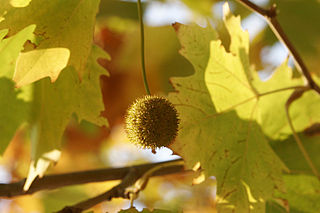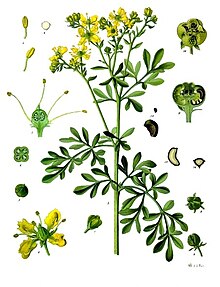
Asteraceae is a large family of flowering plants that consists of over 32,000 known species in over 1,900 genera within the order Asterales. The number of species in Asteraceae is rivaled only by the Orchidaceae, and which is the larger family is unclear as the quantity of extant species in each family is unknown. The Asteraceae were first described in the year 1740 and given the original name Compositae. The family is commonly known as the aster, daisy, composite, or sunflower family.

In angiosperms, a hypanthium or floral cup is a structure where basal portions of the calyx, the corolla, and the stamens form a cup-shaped tube. It is sometimes called a floral tube, a term that is also used for corolla tube and calyx tube. It often contains the nectaries of the plant. It is present in many plant families, although varies in structural dimensions and appearance. This differentiation between the hypanthium in particular species is useful for identification. Some geometric forms are obconic shapes as in toyon, whereas some are saucer-shaped as in Mitella caulescens.

Platanaceae, the "plane-tree family", is a family of flowering plants in the order Proteales. The family consists of only a single extant genus Platanus, with twelve known species. The plants are tall trees, native to temperate and subtropical regions of the Northern Hemisphere. The hybrid London plane is widely planted in cities worldwide.

Petals are modified leaves that surround the reproductive parts of flowers. They are often brightly colored or unusually shaped to attract pollinators. All of the petals of a flower are collectively known as the corolla. Petals are usually accompanied by another set of modified leaves called sepals, that collectively form the calyx and lie just beneath the corolla. The calyx and the corolla together make up the perianth, the non-reproductive portion of a flower. When the petals and sepals of a flower are difficult to distinguish, they are collectively called tepals. Examples of plants in which the term tepal is appropriate include genera such as Aloe and Tulipa. Conversely, genera such as Rosa and Phaseolus have well-distinguished sepals and petals. When the undifferentiated tepals resemble petals, they are referred to as "petaloid", as in petaloid monocots, orders of monocots with brightly colored tepals. Since they include Liliales, an alternative name is lilioid monocots.

The stamen is the pollen-producing reproductive organ of a flower. Collectively, the stamens form the androecium.

A sepal is a part of the flower of angiosperms. Usually green, sepals typically function as protection for the flower in bud, and often as support for the petals when in bloom.

A tepal is one of the outer parts of a flower. The term is used when these parts cannot easily be classified as either sepals or petals. This may be because the parts of the perianth are undifferentiated, as in Magnolia, or because, although it is possible to distinguish an outer whorl of sepals from an inner whorl of petals, the sepals and petals have similar appearance to one another. The term was first proposed by Augustin Pyramus de Candolle in 1827 and was constructed by analogy with the terms "petal" and "sepal".

Commelina is a genus of approximately 170 species commonly called dayflowers due to the short lives of their flowers. They are less often known as widow's tears. It is by far the largest genus of its family, Commelinaceae. The Swedish taxonomist Carl Linnaeus of the 18th century named the genus after the two Dutch botanists Jan Commelijn and his nephew Caspar, each representing one of the showy petals of Commelina communis.

The perianth is the non-reproductive part of the flower, and structure that forms an envelope surrounding the sexual organs, consisting of the calyx (sepals) and the corolla (petals) or tepals when called a perigone. The term perianth is derived from Greek περί and άνθος, while perigonium is derived from περί and γόνος . In the mosses and liverworts (Marchantiophyta), the perianth is the sterile tubelike tissue that surrounds the female reproductive structure.

Menispermaceae is a family of flowering plants. The alkaloid tubocurarine, a neuromuscular blocker and the active ingredient in the 'tube curare' form of the dart poison curare, is derived from the South American liana Chondrodendron tomentosum. Several other South American genera belonging to the family have been used to prepare the 'pot' and 'calabash' forms of curare. The family contains 78 genera with some 440 species, which are distributed throughout low-lying tropical areas with some species present in temperate and arid regions.

Gynoecium is most commonly used as a collective term for the parts of a flower that produce ovules and ultimately develop into the fruit and seeds. The gynoecium is the innermost whorl of a flower; it consists of pistils and is typically surrounded by the pollen-producing reproductive organs, the stamens, collectively called the androecium. The gynoecium is often referred to as the "female" portion of the flower, although rather than directly producing female gametes, the gynoecium produces megaspores, each of which develops into a female gametophyte which then produces egg cells.

Sabiaceae is a family of flowering plants that were placed in the order Proteales according to the APG IV system. It comprises three genera, Meliosma, Ophiocaryon and Sabia, with 66 known species, native to tropical to warm temperate regions of southern Asia and the Americas. The family has also been called Meliosmaceae Endl., 1841, nom. rej.

Abuta is a genus in the flowering plant family Menispermaceae, of about 32 species, native to tropical Central and South America.

Sympetally is a flower characteristic that historically was used to classify a grouping of plants termed Sympetalae, but this term has been abandoned in newer molecular based classifications, although the grouping has similarity to the modern term asterids.

Calyceraceae is a plant family in the order Asterales. The natural distribution of the about sixty species belonging to this family is restricted to the southern half of South America. The species of the family resemble both the family Asteraceae and the Dipsacaceae.

A system of plant taxonomy, the Eichler system was the first phylogenetic (phyletic) or evolutionary system. It was developed by August W. Eichler (1839–1887), initially in his Blüthendiagramme (1875–1878) and then in successive editions of his Syllabus (1876–1890). After his death his colleague Adolf Engler (1844–1930) continued its development, and it became widely accepted.
This glossary of botanical terms is a list of definitions of terms and concepts relevant to botany and plants in general. Terms of plant morphology are included here as well as at the more specific Glossary of plant morphology and Glossary of leaf morphology. For other related terms, see Glossary of phytopathology, Glossary of lichen terms, and List of Latin and Greek words commonly used in systematic names.

Connation in plants is the developmental fusion of organs of the same type, for example, petals to one another to form a tubular corolla. This is in contrast to adnation, the fusion of dissimilar organs. Such organs are described as connate or adnate, respectively. When like organs that are usually well separated are placed next to each other, but not actually connected, they are described as connivent.

Papilionaceous flowers are flowers with the characteristic irregular and butterfly-like corolla found in many, though not all, plants of the species-rich Faboideae subfamily of legumes. Tournefort suggested that the term Flores papilionacei originated with Valerius Cordus, who applied it to the flowers of the bean.

A floral formula is a notation for representing the structure of particular types of flowers. Such notations use numbers, letters and various symbols to convey significant information in a compact form. They may represent the floral form of a particular species, or may be generalized to characterize higher taxa, usually giving ranges of numbers of organs. Floral formulae are one of the two ways of describing flower structure developed during the 19th century, the other being floral diagrams. The format of floral formulae differs according to the tastes of particular authors and periods, yet they tend to convey the same information.
















